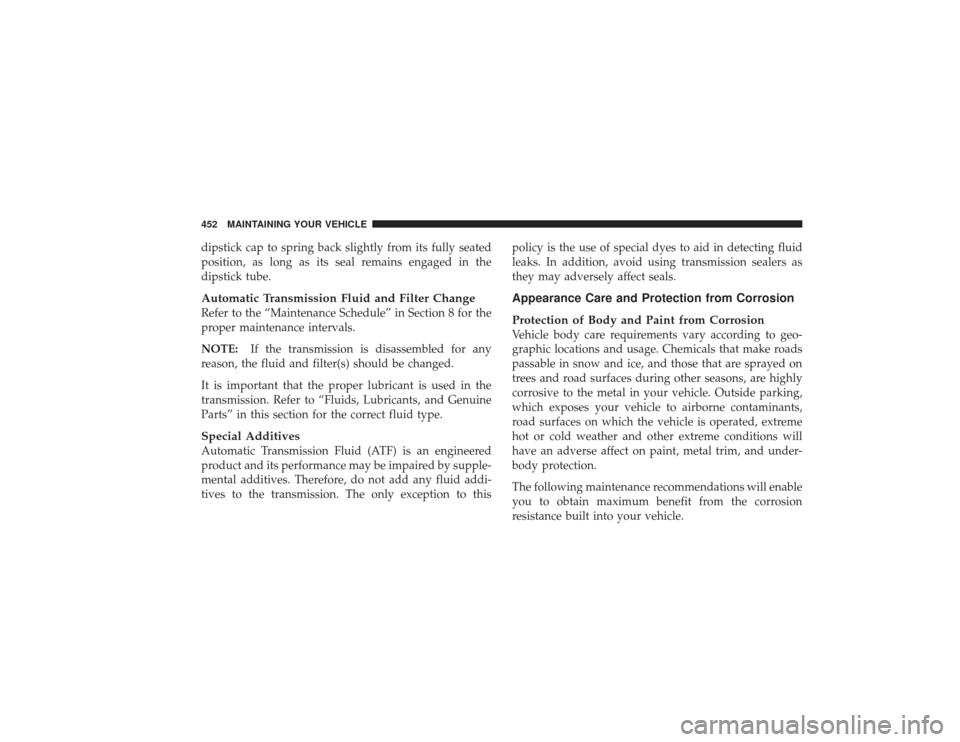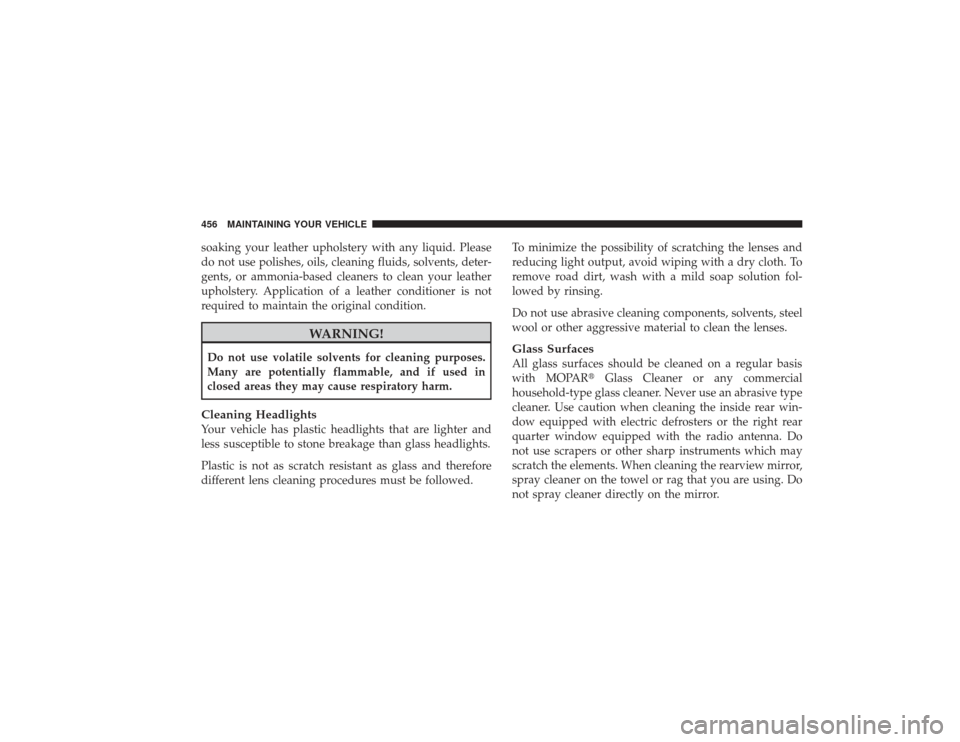Page 454 of 532

dipstick cap to spring back slightly from its fully seated
position, as long as its seal remains engaged in the
dipstick tube.Automatic Transmission Fluid and Filter ChangeRefer to the “Maintenance Schedule” in Section 8 for the
proper maintenance intervals.
NOTE:If the transmission is disassembled for any
reason, the fluid and filter(s) should be changed.
It is important that the proper lubricant is used in the
transmission. Refer to “Fluids, Lubricants, and Genuine
Parts” in this section for the correct fluid type.Special AdditivesAutomatic Transmission Fluid (ATF) is an engineered
product and its performance may be impaired by supple-
mental additives. Therefore, do not add any fluid addi-
tives to the transmission. The only exception to this policy is the use of special dyes to aid in detecting fluid
leaks. In addition, avoid using transmission sealers as
they may adversely affect seals.
Appearance Care and Protection from Corrosion
Protection of Body and Paint from CorrosionVehicle body care requirements vary according to geo-
graphic locations and usage. Chemicals that make roads
passable in snow and ice, and those that are sprayed on
trees and road surfaces during other seasons, are highly
corrosive to the metal in your vehicle. Outside parking,
which exposes your vehicle to airborne contaminants,
road surfaces on which the vehicle is operated, extreme
hot or cold weather and other extreme conditions will
have an adverse affect on paint, metal trim, and under-
body protection.
The following maintenance recommendations will enable
you to obtain maximum benefit from the corrosion
resistance built into your vehicle.
452 MAINTAINING YOUR VEHICLE
Page 458 of 532

soaking your leather upholstery with any liquid. Please
do not use polishes, oils, cleaning fluids, solvents, deter-
gents, or ammonia-based cleaners to clean your leather
upholstery. Application of a leather conditioner is not
required to maintain the original condition.
WARNING!
Do not use volatile solvents for cleaning purposes.
Many are potentially flammable, and if used in
closed areas they may cause respiratory harm.Cleaning HeadlightsYour vehicle has plastic headlights that are lighter and
less susceptible to stone breakage than glass headlights.
Plastic is not as scratch resistant as glass and therefore
different lens cleaning procedures must be followed.To minimize the possibility of scratching the lenses and
reducing light output, avoid wiping with a dry cloth. To
remove road dirt, wash with a mild soap solution fol-
lowed by rinsing.
Do not use abrasive cleaning components, solvents, steel
wool or other aggressive material to clean the lenses.
Glass SurfacesAll glass surfaces should be cleaned on a regular basis
with MOPAR�
Glass Cleaner or any commercial
household-type glass cleaner. Never use an abrasive type
cleaner. Use caution when cleaning the inside rear win-
dow equipped with electric defrosters or the right rear
quarter window equipped with the radio antenna. Do
not use scrapers or other sharp instruments which may
scratch the elements. When cleaning the rearview mirror,
spray cleaner on the towel or rag that you are using. Do
not spray cleaner directly on the mirror.
456 MAINTAINING YOUR VEHICLE
Page 462 of 532
Cavity CartridgeFuseMini
Fuse Description
12 30 Amp Pink Electric Brake
13 25 Amp
NaturalPower-Battery
RWAL/ABS Module
Feed
14 15 Amp
BluePark Lights Left
15 20 Amp
YellowTrailer Park Lights
16 15 Amp
BluePark Lights Right
17 — —
18 40 Amp Green ABS Pump
19 30 Amp Pink Trailer Tow Battery
Feed
Cavity Cartridge
FuseMini
Fuse Description
20 10 Amp
RedOccupant Restraints
Controller (ORC) 2
21 10 Amp
RedOccupant Restraints/
Pass Disable Switch
22 2 Amp
GrayIGN Switch Feed
23 10 Amp
RedHVAC
24 20 Amp Blue AISIN Relay Feed
(Diesel Only)
25 10 Amp
RedPower Mirror/T-Case
Brake
26 20 Amp
YellowBrake Switch/Center
High Mount Stop
Light (CHMSL)/
Aftermarket CHMSL
460 MAINTAINING YOUR VEHICLE
Page 464 of 532
Cavity CartridgeFuseMini
Fuse Description
39 10 Amp
RedSeatbelt Tension
Reducer/Power IGN
Run/Acc
40 20 Amp
YellowPower IGN Run/Acc
— Cigar Lighter/Rear
Power Point
41 — —
42 30 Amp Pink Diesel PCM (Diesel
Only)
CAUTION!
•
When installing the Integrated Power Module
cover, it is important to ensure the cover is prop-
erly positioned and fully latched. Failure to do so
may allow water to get into the Integrated Power
Module, and possibly result in a electrical system
failure.
•
When replacing a blown fuse, it is important to
use only a fuse having the correct amperage rating.
The use of a fuse with a rating other than indicated
may result in a dangerous electrical system over-
load. If a properly rated fuse continues to blow, it
indicates a problem in the circuit that must be
corrected.
462 MAINTAINING YOUR VEHICLE
Page 466 of 532
REPLACEMENT LIGHT BULBSLIGHT BULBS — InteriorBulb No.
Overhead Console Lights ............... TS212-2
Dome Light ............................ 7679
NOTE: For lighted switches, see your authorized dealer
for replacement instructions.
All of the inside bulbs are brass or glass-wedge base.
Aluminum base bulbs are not approved. LIGHT BULBS — Exterior
Bulb No.
Backup ............................... 3057
Center High Mounted Stop Light ............. 912
Fog Light ........................... 9006LL
Headlight (Halogen) ...................... H13
Side Marker, Park & Turn Signal .........3157NAK
Rear License Plate Light .................... 168
Rear Cargo Light ......................... 912
Tail & Stop ............................ 3057
Cab Clearance Lights ...................... 168
Dual Rear Wheel Sidemarker Light ............ 168
Dual Rear Wheel Tailgate ID Lights (3) ......... 168464 MAINTAINING YOUR VEHICLE
Page 467 of 532
BULB REPLACEMENT
Headlight (Halogen)/Front Park and Turn Lights
CAUTION!
This is a halogen bulb. Avoid touching the glass with
your fingers. Reduced bulb life will result.
1. Open the hood
2. Remove the two bolts from the front of the headlight
housing.
Front Headlight Housing Bolts
MAINTAINING YOUR VEHICLE 465
7
Page 468 of 532
3. Remove the plug from the inner fender well and
remove the nut through the access hole.4. Pull the housing out from the fender to allow room to
disconnect the electrical connectors.
NOTE:For easier removal, pull the headlight assembly
straight forward, applying the greatest amount of force to
the outer edge of the headlight assembly.
Inner Fender Plug
Rear Headlight Housing Nut Access
466 MAINTAINING YOUR VEHICLE
Page 469 of 532
5. Unlock and pull the connector straight from the base
of the headlight halogen bulb.
6. Twist the connector on the side marker/turn signal/
park light bulb
1�4turn and remove the connector and
bulb from housing.
Headlight Removal
Bulb Removal
MAINTAINING YOUR VEHICLE 467
7